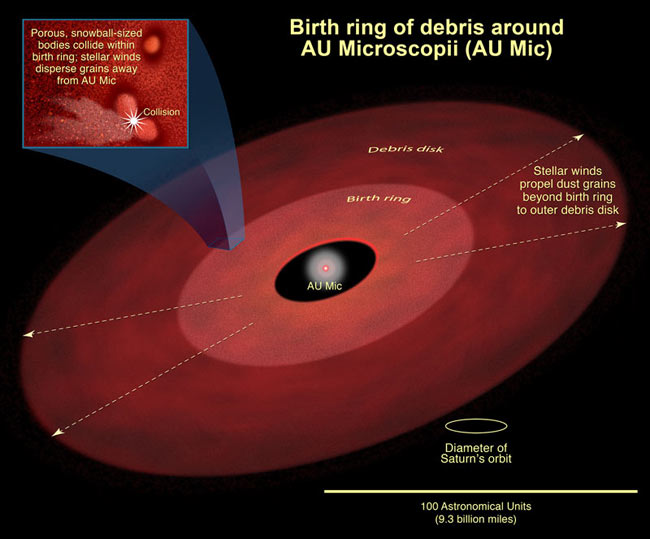
SEATTLE - A flurry of lint-like particles discovered swirling around a small, distant star could help explain how miniscule interstellar dust grains clump together to form planets, astronomers say.
"We have seen many seeds of planets and we have seen many planets, but how they go from one to the other is a mystery," said study team member James Graham of the University of California, Berkeley. "These observations help us to fill in that gap."
The newfound fluffy particles are about ten times larger than interstellar dust grains and about as porous as newly fallen snow, which is composed of about 97 percent air and only 3 percent ice.
Space lint
Another good comparison is lint from a drying machine, Graham said. The two types of materials have roughly the same porosity and are held together by the same molecular forces.
The space lint was detected in a disk encircling AU Microscopii, a relatively young red dwarf star, just 12 million years old, located 32 light-years from Earth [image].
The researchers used polarizing filters on the Hubble Space Telescope's Advanced Camera for Surveys to blot out the main portion of Au Microscopii's light so that only light reflected off the star's debris disk was visible.
Get the Space.com Newsletter
Breaking space news, the latest updates on rocket launches, skywatching events and more!
By examining the reflected starlight, the researchers deduced information about certain properties of the particles, including size and shape.
"The way that light scatters depends on the refractive index of the material...[which] tells you how light rays get bent," Graham explained. The refractive index of a material depends on how porous the material is, and a low value is indicative of porous materials.
Researchers think the fluff was shed when larger, soft-ball sized objects-also fluffy-collided. Dubbed "parent bodies," these objects are thought to be the precursors to even larger entities which eventually coalesce to form planets.
"Once they exceed softball sizes, they start to become compactified. The vacuum in between the grains get filled with more material," Graham said in a news conference Sunday at the 209th meeting of the American Astronomical Society. "The fact that we see this low porosity means that the parent bodies haven't grown too big."
The "birth ring"
The parent bodies are thought to reside within a tumultuous region located near the center of the star called the "birth ring" [image].
First predicted by astronomers in 2005, the birth ring is thought to extend out to a distance of up to 4.6 billion miles from the star. Within this ring, collisions are more likely to occur and it is in this region that planets are most likely to form.
Crashing parent bodies are thought to shed the fluff, which is then blown outwards by the star's intense solar winds.
The discovery of the fluffy particles could affect astronomers' theories about how planets form, said study team member Paul Kalas, also of UC Berkeley.
For example, he said, to calculate the mass of a rock with no porosity, scientists cube the value of its radius. But for a porous object, this relationship no longer holds, and mass is a function of the radius squared.
"So let's say you have a theoretician wants to make a model of how everything in the solar system forms," Kalas said. "If he starts off with that basic physics result that mass is proportional to radius cubed, he would get the wrong answer because we're starting from very porous fragments."
Kalas said that future research might focus on whether a similar fluff surrounds other stars.
"It would be interesting to see how this porosity changes with the mass and luminosity of the star," he said.
Editor's Note: All week, SPACE.com is providing complete coverage of the 209th meeting of the American Astronomical Society.
- All About Planets
Join our Space Forums to keep talking space on the latest missions, night sky and more! And if you have a news tip, correction or comment, let us know at: community@space.com.
Ker Than is a science writer and children's book author who joined Space.com as a Staff Writer from 2005 to 2007. Ker covered astronomy and human spaceflight while at Space.com, including space shuttle launches, and has authored three science books for kids about earthquakes, stars and black holes. Ker's work has also appeared in National Geographic, Nature News, New Scientist and Sky & Telescope, among others. He earned a bachelor's degree in biology from UC Irvine and a master's degree in science journalism from New York University. Ker is currently the Director of Science Communications at Stanford University.









